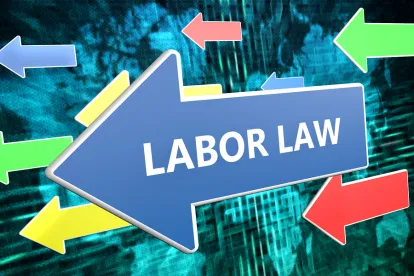-
The National Labor Relations Board General Counsel’s office is advocating for overturning Trump-era Board cases defining the scope of National Labor Relations Act-protected activity. In a brief filed on January 14, The NLRB General Counsel’s office urged the Board to overturn current precedent addressing when workers’ actions are protected under the NLRA. In American Federation for Children, 28-CA-246878 (brief filed Jan. 13, 2022), General Counsel (GC) Jennifer Abruzzo appealed an administrative law judge’s (ALJ) finding that an employer did not violate the NLRA when it discharged a worker after she expressed concern that a supervisor sabotaged the work authorization and rehire a former coworker out of anti-immigrant bias. In particular, the GC targeted a 2019 Trump-era NLRB decision the ALJ relied upon in American Federation for Children to find the expressed concerns were not concerted because other employees did not join in the activities and some employees were offended by them. Inthe 2019 decision, the NLRB found protected activity requires more than the mere presence of other coworkers when an individual raises workplace concerns. The GC’s brief criticized that decision as a new, arbitrary constraint on the NLRA’s protection, which undermined its purpose. The request to overturn these cases is in line with the Biden-appointed GC’s aggressive approach to overhauling federal labor law.
-
The NLRB GC asserts that consequential damages should be included in any make-whole remedy. In a brief filed on January 10 in response to the NLRB’s invitation for public comment in Thryv Inc., 371 NLRB No. 37 (2021), GC Abruzzo argued the Board’s make-whole remedy should include the consequential damages of job loss, such as emotional harm, injury to character, professional standing, or reputation. In Thryv Inc., the NLRB is considering awarding consequential damages related to allegations that six employees were unlawfully laid off. Citing other employment-related statutes providing for emotional harm relief, such as the Fair Labor Standards Act (FLSA) and the Occupational Safety and Health Act, the GC’s office contended emotional distress is a foreseeable result of an unfair labor practice violation and damages for such harm should be built into the Board’s framework for make-whole remedies based on rulings under those statutes. The make-whole remedy for an unlawful discharge under current NLRB law typically includes reinstatement, backpay, and costs of searching for a new job. Business groups have opposed the new changes, noting consequential damages such as emotional distress are too far removed from the traditional backpay remedy.
-
House Democrats are advocating for the NLRB to reinstate the Obama-era micro bargaining unit standard. The House Education and Labor Committee filed a brief arguing the Board should return to the standard for determining the appropriateness of a bargaining unit articulated in the Obama-era case Specialty Healthcare and Rehabilitation Center, 357 NLRB 934 (2011). That case permitted union elections in “micro units” by tightening the traditional community of interests test employers needed to satisfy to show the unit is inappropriate without the addition of employees. The Democrats argue the legislative history of the NLRA shows Congress’ approval of small bargaining units, and the return to the Specialty Healthcare standard would advance the policies of the NLRA and improve the United States’ compliance with its obligations under international law. The brief was filed in response to the NLRB’s invitation for public input in American Steel Construction, 371 NLRB No. 41 (2021), where the Board granted review of a Regional Director’s decision finding a petitioned-for unit of only ironworkers in a larger plant inappropriate.
-
U.S. union membership dropped to a record low. Despite several high-profile labor actions, including a strike of 10,000 UAW bargaining unit employees at John Deere and union organizing drives at Starbucks outlets and at an Amazon warehouse in Alabama, union membership in the United States dropped in 2021 to tie a record low of 10.3%. When public sector workers are excluded from the calculation, the percentage is 6.1% for 2021. The U.S. Bureau of Labor Statistics (BLS) reported that union membership dropped by 0.5% from 2020, matching the previous 2019 historically low percentage. Additionally, the total number of union members decreased by 241,000, despite an overall drop in the unemployment rate. The BLS noted that the uptick to 10.8% in 2020 was due to a decline in nonunion workers rather than an increase in union workers.
-
The Department of Labor (DOL) and NLRB agreed to share information on potential labor violations. The DOL, Wage and Hour Division and the NLRB released a Memorandum of Understanding (MOU) detailing the federal agencies’ agreement to share information regarding potential violations of federal labor law. The Wage and Hour Division is responsible largely for enforcing the FLSA, the law that sets the national minimum wage and overtime standards, while the NLRB is the administrative body of the NLRA, which establishes the rights of employees to be represented by a union or not and to raise workplace concerns with their employer. Historically, an employee who wanted to allege violations of both laws would have to coordinate investigations with each agency independently. The MOU seeks to change that approach with “greater coordination in information sharing, joint investigations and enforcement activity, training, education, and outreach.” Some see the sharing agreement as a sign the Biden Administration is executing on its promise to come down on misclassification of employees as independent contractors, a legal issue that has significant overlap with both agencies.
Thomas V. Walsh and Megann K. McManus contributed to this article.








 />i
/>i
